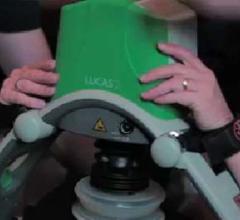
June 7, 2013 — Extracorporeal membrane oxygenation (ECMO), a procedure traditionally used during cardiac surgeries and in the intensive care unit (ICU) that functions as an artificial replacement for a patient's heart and lungs, has also been used to as a resuscitation device for cardiac arrest victims in Japan, Taiwan and South Korea. Now, a novel study of this technique in the United States has been completed by researchers at the Perelman School of Medicine at the University of Pennsylvania, indicating a potential role for this intervention to save patients who are unable to be resuscitated through conventional measures.
ECMO directly oxygenates and removes carbon dioxide from the blood, and is used for both respiratory and cardiac failure. The procedure requires 24/7 monitoring and care for the duration of the treatment, but it provides a critical backup for patients whose heart and lungs are so severely diseased or damaged that they can no longer function.
"Over the last decade, we have made great strides in the field of cardiac resuscitation science, including the development of novel methods of therapeutic hypothermia and the use of cardiac bypass following cardiac arrest," said lead study author David Gaieski, M.D., an associate professor of Emergency Medicine in the Perelman School of Medicine and clinical director of Penn's Center for Resuscitation Science. "Yet cardiac arrests still take the lives of more than 300,000 Americans each year, and we are continuing to explore how to use new and expanded strategies to help save these patients. Based on the work of our colleagues in Asia, we sought to report our own experience using ECMO for a select set of patients with refractory cardiac arrest and profound shock."
For the study, the research team used a collaborative approach between clinicians in the Department of Emergency Medicine and surgeons within the Division of Cardiovascular Surgery at Penn to assess the outcomes for select patients undergoing ECMO presenting in the emergency department (ED) and for in-hospital cardiac arrests at the Hospital of the University of Pennsylvania.
They studied the approach in patients who otherwise would have died — who were unable to be resuscitated through CPR and defibrillation and who would not have been eligible for other post-arrest therapies such as therapeutic hypothermia.
Inclusion criteria for ED patients included witnessed arrest, bystander CPR and an initial shockable rhythm. For in-patient arrests, inclusion criteria included presumed cardiac etiology of arrest or refractory shock unresponsive to conventional interventions. Main variables were whether a patient was in cardiac arrest or profound shock and location of patient at time of initiation of ECMO, with the primary outcome of survival to hospital discharge.
Thirty-three patients were included in the study. Of these patients, the mean age was 50 years and 70 percent were men. Three-quarters of the patients were treated for cardiac arrest, and the remainder were treated for refractory shock. Using the ECMO strategy, 21 percent of the patients survived to discharge and five were neurologically intact.
"This preliminary study shows that using ECMO in a collaborative model between emergency physicians and cardiothoracic surgeons can be a useful rescue tool in select cardiac arrest and shock patients. The results are promising given that among patients that regain a pulse after cardiac arrest, only one out of three survive to hospital discharge," said senior study author Michael Acker, M.D., chief, Division of Cardiovascular Surgery at Penn Medicine.
For more information: www.uphs.upenn.edu

 April 02, 2019
April 02, 2019 



